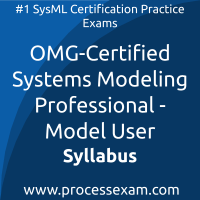 To achieve the professional designation of OMG-Certified Systems Modeling Professional - Model User from the OMG, candidates must clear the OMG-OCSMP-MU100 Exam with the minimum cut-off score. For those who wish to pass the OMG OCSMP certification exam with good percentage, please take a look at the following reference document detailing what should be included in OMG SysML MU Exam preparation.
To achieve the professional designation of OMG-Certified Systems Modeling Professional - Model User from the OMG, candidates must clear the OMG-OCSMP-MU100 Exam with the minimum cut-off score. For those who wish to pass the OMG OCSMP certification exam with good percentage, please take a look at the following reference document detailing what should be included in OMG SysML MU Exam preparation.
The OMG-OCSMP-MU100 Exam Summary, Sample Question Bank and Practice Exam provide the basis for the real OMG-Certified Systems Modeling Professional - Model User exam. We have designed these resources to help you get ready to take OMG-Certified Systems Modeling Professional - Model User (OMG-OCSMP-MU100) exam. If you have made the decision to become a certified professional, we suggest you take authorized training and prepare with our online premium OMG OCSMP Practice Exam to achieve the best result.
OMG-OCSMP-MU100 Exam Summary:
| Exam Name | OMG-Certified Systems Modeling Professional - Model User |
| Exam Code | OMG-OCSMP-MU100 |
| Exam Fee | USD $350 |
| Residents of English-speaking Countries Exam Duration | 90 Minutes |
| All others Exam Duration | 120 Minutes |
| Number of Questions | 90 |
| Passing Score | 56 / 90 |
| Format | Multiple Choice Questions |
| Books / Trainings | Systems Engineering with SysML/UML |
| Schedule Exam | Pearson VUE |
| Sample Questions | OMG SysML MU Exam Sample Questions and Answers |
| Practice Exam | OMG-Certified Systems Modeling Professional - Model User Practice Test |
OMG OCSMP Syllabus Topics:
| Topic | Details | Weights |
|---|---|---|
MODELS OF SYSTEM STRUCTURE - 36% |
||
| Interpreting System Structure on Block Diagrams | - Block definition and description, including definition vs. usage, valuetype (with units), block features including value properties, parts, references and operations. Block Definition Diagram description, purpose, and benefits, compartments, relationships between blocks including specialization and associations (including composite but not shared aggregation), multiplicities. Internal Block Diagram description, purpose, and benefits, enclosing block, flow ports and standard ports, connectors and item flows as well as representation of parts. | 22% |
| Interpreting Model Organization on Package Diagrams | - Package Diagram description, purpose, and benefits, aspects of packages including ownership of elements and defining a namespace, relationships including containment and dependency, and concepts of view and viewpoint. | 7% |
| Interpreting System Constraints on Block Definition Diagrams and Parametric Diagrams | - Interpreting constraint blocks on Block Definition Diagrams, Parametric Diagram description, purpose and benefits, constraint properties, parameters and expressions, connecting constraint properties and value properties with binding connectors. | 7% |
MODELS OF SYSTEM BEHAVIOR - 30% |
||
| Interpreting Flow-Based Behavior on Activity Diagrams | - Activity Diagram description, purpose, and benefits, I/O flow including object flow, parameters, parameter nodes and pins, control flow including control nodes, activity partitions (swimlanes) and actions including decomposition of activities using call behavior action, send signal action, as well as accept event action. | 13% |
| Interpreting Event-Based Behavior on State Machine Diagrams | - State Machine Diagram description, purpose, and benefits, states and regions including state, regions, initial state and final state, transitions including trigger by time and signal events, guard and action (i.e., effect), as well as behaviors including entry, exit and do. | 10% |
| Interpreting Message-Based Behavior on Sequence Diagrams | - Sequence Diagram description, purpose and benefits, lifelines, asynchronous and synchronous messages, and interaction references (to elements outside the diagram). | 7% |
CROSS-CUTTING CONSTRUCTS - 20% |
||
| Interpreting Allocations Across Multiple Diagram Types; Other Topics | - Allocation description, purpose and usage, AllocatedFrom and AllocatedTo, representation including callouts, compartments, allocate activity partitions, and tables, special notations for comment, rationale, problem and constraint. Some concepts relating to diagrams: diagram frames, ports, parameters and anchors on diagram frames, diagram header and diagram description as well as stereotype. | 20% |
MODELS OF REQUIREMENTS - 14% |
||
| Interpreting Requirements on Requirement Diagrams | - The concept of "requirement", key relationships including derive, verify, satisfy, refine, trace, containment as well as the Requirement Diagram description, purpose and benefits. | 7% |
| Interpreting System Functionality on Use Case Diagrams | - Use Case Diagram description, purpose and benefits, use case structure encompassing use case, actor and subject, as well as basic relationships including association, include, extend and generalization. | 7% |
Both OMG and veterans who’ve earned multiple certifications maintain that the best preparation for a OMG-OCSMP-MU100 professional certification exam is practical experience, hands-on training and practice exam. This is the most effective way to gain in-depth understanding of OMG SysML MU concepts. When you understand techniques, it helps you retain OMG OCSMP knowledge and recall that when needed.
